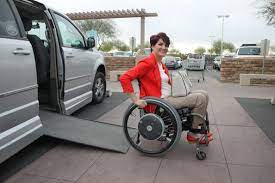Will I be able to drive again?
While you are in the spinal unit, you will have the opportunity to have a driving assessment.
The assessment is carried out by registered occupational therapists.
The amount of time after your injury is a major factor in deciding whether and how you can return to driving. You may see many improvements in your abilities several weeks or months after your injury. With time, you may regain some functions that could make driving possible.
Your doctor can refer you to a driving rehabilitation specialist for a full evaluation to decide if you are ready and able to drive.
A full driving assessment will evaluate:
- Medical data/driving history/driving goals.
- Vision
- Strength and range of motion
- Cognitive ability (if indicated)
- Ability to transfer
- Wheelchair or other mobility device loading
- Behind-the-wheel driving to try out equipment options
What the driving assessment involves
First, you will have an assessment in the therapist’s office. (This is called an off-road assessment.) Then they will take you out for a practical driving assessment. (This is called an on-road assessment.)
The off-road assessment
This part of the assessment will take up to two hours. The occupational therapist will carry out a thorough check of:
- your vision (basic screening)
- your physical functions (such as range of movement, strength, sensation and coordination)
- your judgement
- your memory
- your directional orientation
- your movement and decision making times
- how your mind understands what you see
- your knowledge of road rules and signs.
The therapist may use a computer-based tool (assistive technology) for part of this assessment.
The on-road assessment
Occasionally, a driver’s off-road assessment suggests they should not be driving. If this happens, the occupational therapist may still want you to proceed with the on-road assessment, to confirm the off-road assessment results.
The on-road assessment further assesses the impact that any disability or illness, or aging, might be having on your ability to drive safely.
During the on-road assessment, you will be accompanied by the occupational therapist. Sometimes a specially trained driving instructor will be there as well.
You will tackle a range of driving situations – for example:
- driving on both the open road and urban roads
- driving through controlled and uncontrolled intersections
- parking
- manoeuvring.
The on-road assessment may involve approximately 40-60 minutes of driving.
If you don’t have a current driver licence, make your assessor aware of this at least one week before the assessment, so they can get one on your behalf. Without a temporary licence, you will be unable to sit the on-road assessment.
What happens after the driving assessment?
When you have finished both parts of the driving assessment, the occupational therapist will write a report outlining their observations and providing a professional recommendation.
This report will be sent back to the health practitioner who asked for you to be assessed.
The health practitioner will read the report then decide whether they consider you medically fit to drive the classes or endorsements that you wish to apply for or renew.
If the health practitioner gives you a medical certificate confirming you are fit to drive, you can continue with your driver licensing application.
If you want more information, you can:
- Speak to your health practitioner
- Contact Occupational Therapy New Zealand Whakaora Ngangahau Aotearoa at www.otnz.co.nz
- Email: otnz@otnz.co.nz


